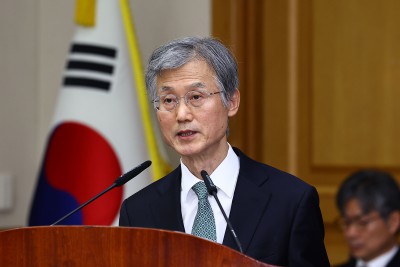19. We commend the progress recently achieved in the area of tax transparency and we fully endorse the OECD proposal for a truly global model for multilateral and bilateral automatic exchange of information. We are committed to automatic exchange of information as the new, global standard and we fully support the OECD work with G20 countries aimed at setting such a new single global standard for automatic exchange of information. We ask the OECD to prepare a progress report by our next meeting, including a timeline for completing this work in 2014. We call on all jurisdictions to commit to implement this standard. We are committed to making automatic exchange of information attainable by all countries, including low-income countries, and will seek to provide capacity building support for them. We call on all countries to join the Multilateral Convention on Mutual Administrative Assistance in Tax Matters without further delay. We look forward to the practical and full implementation of the new standard on a global scale. All countries must benefit from the new transparent environment and we call on the Global Forum on Exchange of Information for Tax Purposes to work with the OECD task force on tax and development, the World Bank Group and others to help developing countries identify their need for technical assistance and capacity building. We are looking forward to the Global Forum establishing a mechanism to monitor and review the implementation of the global standard on automatic exchange of information. We urge all jurisdictions to address the Global Forum’s recommendations and especially the fourteen where the legal framework fails to comply with the standard without further delay. We ask the Global Forum to draw on the work of the FATF in connection with beneficial ownership, and also ask the Global Forum to achieve the allocation of overall ratings regarding the effective implementation of
information exchange upon request at its November meeting and report to us at our first meeting in 2014.
20. We reiterate our commitment to FATF’s work in fighting money laundering and terrorism financing and its key contribution into tackling other crimes such as tax crimes, corruption, terrorism, and drug trafficking. In particular, we support the identification and monitoring of high risk jurisdictions with strategic anti-money laundering (AML)/countering the financing of terrorism (CFT) deficiencies while recognizing the countries’ positive progress in fulfilling the FATF’s standards. We encourage all countries to tackle the risks raised by opacity of legal persons and legal arrangements, and we commit to take measures to ensure that we meet the FATF standards regarding the identification of the beneficial owners of companies and other legal arrangements such as trusts that are also relevant for tax purposes. In the prudential area we call for further progress and encourage adherence to cooperation and information exchange standards.
Financial Regulation
21. Since our April meeting, further progress has been made in promoting financial system stability with additional jurisdictions adopting final rules to implement Basel III. Those who have not yet adopted final rules have committed to do so as soon as possible in 2013. We welcome the work of the Basel Committee on Banking Supervision (BCBS) to assess the consistency of jurisdictions’ rules with Basel III and look forward to the updated progress report on Basel III implementation ahead of the Summit. We welcome the recent BCBS report on the regulatory consistency of risk-weighted assets and look forward to their further work to improve comparability of regulatory capital ratios. We expect the BCBS to finalize its work on the remaining components of the Basel III framework - the leverage ratio by early 2014 and on net stable funding ratio by end 2014.
22. The FSB will report to the St Petersburg Summit on the progress made and next steps towards addressing the “too big to fail” issue. We strongly support the work to establish robust resolution regimes and resolution plans consistent with the scope and substance of the FSB’s Key Attributes of Effective Resolution for any financial institution that could be systemically important beyond the banking sector, and look forward to pilot assessments by the FSB, IMF and World Bank using the Key Attributes’ assessment methodology. We will undertake any legislative and other steps needed to enable authorities to resolve financial institutions in an effective manner, including in a cross-border context. We further encourage the FSB and IMF to continue work to address cross-border resolution issues. We recognize that structural banking reforms can facilitate resolvability and call on the FSB, in collaboration with the IMF and the OECD, to assess cross-border consistencies and global financial stability implications taking into account country-specific circumstances.
23. We support the work done by the International Association of Insurance Supervisors (IAIS) and the FSB to finalize the Global Systemically Important Insurers (G-SII) package. We welcome the publication of the initial list of G-SIIs to which resolution planning and group-wide supervision will initially apply. We welcome the IAIS plans to develop a simple, group-
wide capital requirement to be finalized by the time of the G20 Summit in 2014 and that will serve as a foundation for higher loss absorbency requirements for G-SIIs.
24. We note the continued progress in implementing OTC derivatives reforms, and that further work remains to ensure greater consistency in regulatory standards. We are committed to rapidly complete the remaining legislative frameworks and regulations for these reforms. In particular, the recent EU-U.S. announcement on cross-border issues related to OTC derivatives reforms is a major constructive step forward, which paves the way for resolving remaining conflicts, inconsistencies, gaps and duplicative requirements globally. Further steps remain needed, and we have asked key regulators to report by the September Summit on how they have resolved these cross-border issues. In this context, we agree that jurisdictions and regulators should be able to defer to each other when it is justified by the quality of their respective regulations and enforcement regimes, based on essentially identically outcomes, in a non-discriminatory way, paying due respect to home country regulation regimes.
25. We support the Regulatory Oversight Committee (ROC) of the Legal Entity Identifier (LEI) in its efforts to launch the global LEI Foundation as soon as possible.
26. We look forward to further FSB policy recommendations for the oversight and regulation of the shadow banking system by the Leaders’ Summit and will work towards their timely implementation.
27. The above are important steps taken by the international community in rebuilding confidence in the long-term robustness of the global financial system. We will continue to monitor and assess their impact on the financial system and on economic growth.
28. We reiterate our call on the IASB and FASB to finalize by the end of 2013 their work on key outstanding projects for achieving convergence on a single set of high-quality accounting standards. We recall the crucial importance of making swift progress on this issue in order to enhance resilience of financial markets.
29. We note the outcomes of the G20 high-level seminar on benchmarks and credit rating agencies (CRAs). We look forward to the FSB progress report on both national authorities’ and standard setting bodies’ steps to reduce reliance on CRA ratings for the St Petersburg Summit. We welcome the completion of IOSCO’s Principles for Financial Benchmarks and the establishment of the FSB’s Official Sector Steering Group to coordinate work on the necessary reforms of interest rate benchmarks and guide the work of a Market Participants Group.
30. As a pre-requisite for enhanced policy analysis, we welcome the continued progress made by G-20 economies on closing information gaps under the FSB and IMF G-20 Data Gaps Initiative. We strongly encourage the implementation of the recommendations in this initiative and look forward to the progress report for our meeting in October 2013.
[뉴스핌 Newspim] 김동호 기자 (goodhk@newspim.com)
























